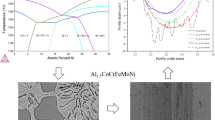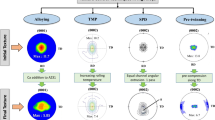Abstract
The present work examines different glass forming ability criteria (GFA), which distribute into four major categories based on different theories for glassy alloys. Four major categories are based on (i) characteristics transformation temperatures, (ii) Miedema approach, (iii) internal atomic configuration, and (iv) kinetic constraints (viscosity, diffusivity, etc.). Twelve alloys of widely different origin and nature (with respect to number of constituent elements, base element, critical casting thickness, etc.) have been selected for studying the applicability of different GFA criteria of different categories. The experimentally determined critical casting thickness (Zmax) of each alloy has been taken to be the measure of GFA. The best criterion of each category has been identified. Finally, it has been observed that no single criterion of any category alone shows satisfactory correlation with Zmax. However, two criteria of two different categories do not simultaneously fail. It has been concluded that to determine GFA of any random glass forming material, two different criteria of two different categories should be checked. If both results do not indicate similarity in them, GFA must be checked with third criteria of third category.





Similar content being viewed by others
References
Turnbull D, Contemp Phys 10 (1969) 473.
Inoue A, Zhang T, and Mashumoto T, J Non Cryst Sol 156–158 (1993) 473.
Mondal K, and Murty B S, J Non Cryst Sol 351 (2005) 1366.
Yuan Z Z, Bao S L, Lu Y, Zhang D P, and Yao L, J Alloy Compd 459 (2008) 251.
Lu Z P, and Liu C T, Acta Mater 50 (2002) 3501.
Chen Q J, Shen J, Fan H B, Sun J F, Huang Y J, and Mccartney D G, Chin Phys Lett 22 (2005) 1736.
Fan G J, Choo H, and Liaw P K, J Non Cryst Sol 353 (2007) 102.
Ji X, and Pan Y, Trans Nonferrous Met Soc China 19 (2009) 1271.
Guo F Q, Poon S J, and Shiflet G J, Scripta Materialia 43 (2000) 1089.
Miedema A R, Boom R, and De Boer F R, J Less Common Metals 41 (1975) 283.
Miedema A R, and Niessen A K, Physica B 114 (1982) 367.
Miedema A R, de Chatel P F, and de Boer F R, Physica B 100 (1980) 1.
Xia L, Li W H, Fang S S, Wei B C, and Dong Y D, J Appl Phys 99 (2006) 1.
Ji X, Pan Y, Ni F, Mater Des 30 (2009) 842.
Monsoori G A, Carnhan N F, Starling K E, Lel and Jr T W, J Chem Phys 54 (1971) 1523.
Bhatt J, Jiang W, Junhai X, Qing W, Dong C, and Murty B S, Intermetallics 15 (2007) 716.
Bhatt J, Dey G K, and Murty B S, Met Mat Trans A 39 (2008) 1543.
Bhatt J, and Murty B S, J Alloy Compd 459 (2008) 135.
Bhatt J, and Murty B S, Trans IIM 62 (2009) 413.
Bhatt J and Murty B S, Mater Sci Forum 649 (2010) 67.
Weinberg M C, Uhlmann D R, and Zanotto E D, J Am Ceram Soc 72 (1989) 2054.
Weinberg M C, Zelinski B J, and Uhlmann D R, J Non Cryst Sol 123 (1990):90.
Chattopadhyay C, Sangal S, and Mondal K, Bull Mater Sci (2012) (accepted).
Niessen A K, de Boer P R, Boom R, de Chiitel P F, Mattene W C M, and Miedema A R, CALPHAD 7 (1983) 51.
Takeuchi A, and Inaoue A, Mater Trans (JIM) 42 (2001) 1435.
Ray P K, Akinc M, and Kramer M J, J Alloy Compd 489 (2010) 357.
Angell C A, Science 267 (1995) 1924.
Mondal K, and Murty B S, Mater Sci Eng A 454–455 (2007) 654.
Johnson W A, and Mehl R F, Trans Am Inst Min Metall Eng 135 (1939) 416.
Avrami M, J Chem Phys 7 (1939) 1103.
Avrami M, J Chem Phys 8 (1940) 212.
Avrami M, J Chem Phys 9 (1941) 177.
Mondal K, and Murty B S, Mater Sci Eng A 454–455 (2007) 654.
Turnbull D, J Appl Phys 31 (1950) 1022.
Kholodenko A L, and Douglas J F, Phys Rev E 51 (1995) 1081.
Author information
Authors and Affiliations
Corresponding author
Rights and permissions
About this article
Cite this article
Chattopadhyay, C., Sangal, S. & Mondal, K. On the Unavailability of Universal Glass Forming Ability Criterion. Trans Indian Inst Met 67, 451–458 (2014). https://doi.org/10.1007/s12666-013-0373-4
Received:
Accepted:
Published:
Issue Date:
DOI: https://doi.org/10.1007/s12666-013-0373-4




